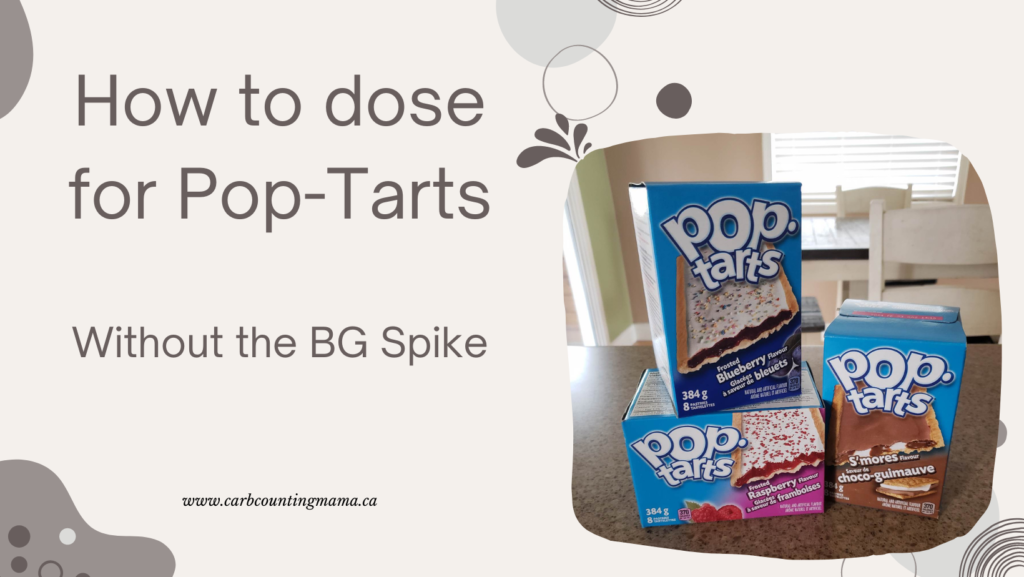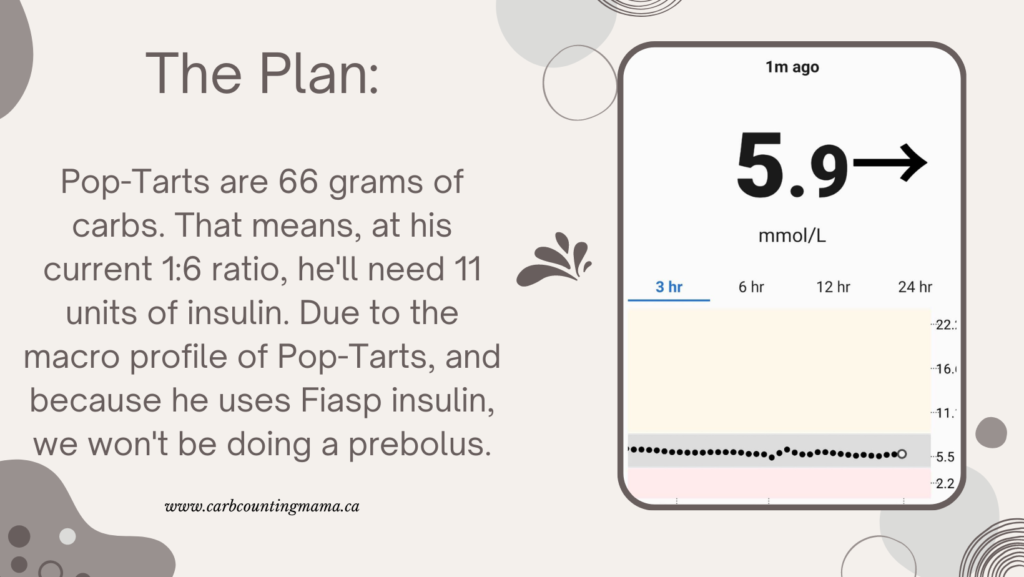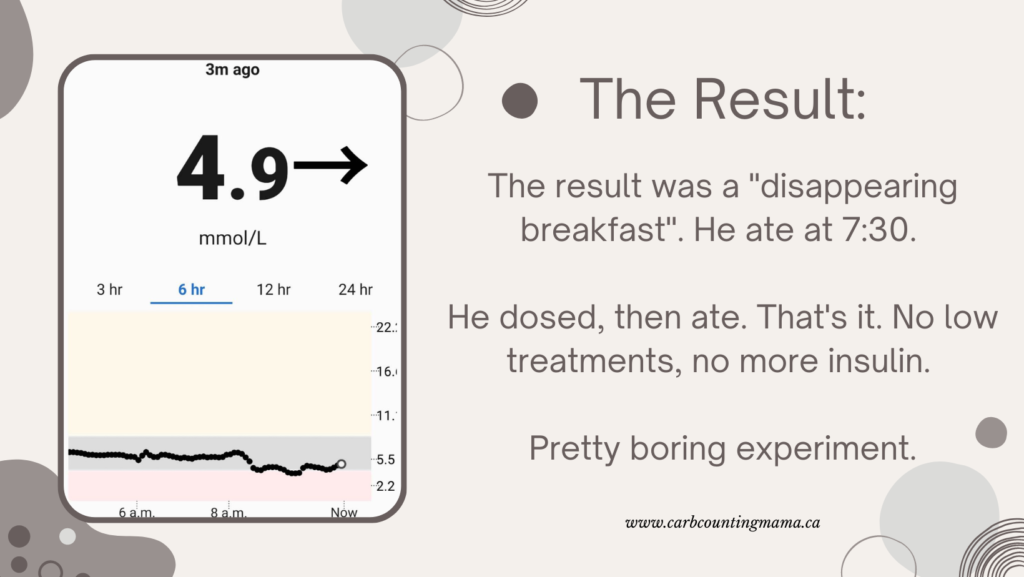Pop-Tarts. Not the healthiest breakfast or snack by any measure. However, they’re fun and easy to grab and go. Having a little treat now and then is nice. But at 65ish grams of carbs per pack, these little guys pack quite the punch! So, if we’re going to be having Pop-Tarts, we should come up with a solid plan for insulin dosing.

This post contains affiliate links
I am not a doctor or medical professional. This article is for informational purposes only. If you are thinking about changing the way you treat your diabetes, consult your medical team for assistance.
Our basic goal, as is our goal with every snack and meal, is to eat, dose, and keep bg in range. Let’s figure out how to make that happen with Pop-Tarts.
Some important info before we start:
- Before starting, we did a basal test and tested Jordan’s breakfast carb ratio. Both are accurate for his day-to-day life.
- Jordan currently manages his T1D with MDI. He tends to dose for food using his stomach as his injection site (yes, the location of the insulin injection is important for this experiment).
- The insulins he uses are Tresiba (which is considered to be an ultra-long-acting insulin with no discernable peak) and Fiasp (which is an ultra-rapid-acting insulin that starts working within a few minutes and has a duration similar to other rapid-acting insulins).
This may be similar to the way you manage T1D, or it might be very different. Different insulins and management methods will change the way all of this works. Even if you do things exactly the same way that Jordan and I do, this might not work the same for you. It’s meant as a demonstration not any kind of T1D instructions.
The plan for Pop-Tarts
Of course, the carb count is important so that we can figure out how much we should be dosing. In this case, S’mores Pop-Tarts are 66 grams of net carbs per pack. This makes it really easy for us since Jordan’s current ICR is 1:6. That means he’ll need 11 units of insulin to cover the carbs from the Pop-Tarts.
Depending on his bg before eating, we may need to add some insulin to the 11 units we’ve already calculated. But ideally, any time he eats, we want his bg to be in range and steady. That just takes some of the guesswork out of the equation.
The next thing I look at is the macro profile of the food. It’s not just carbs that affect bg numbers and insulin dosing.
For these Pop-Tarts, there are 67 grams of carbs, 1 gram of fiber, 9 grams of fat, and 5 grams of protein.
The fiber doesn’t make much of a difference in this case, but we use net carbs for dosing, so we’ll dose for 66 grams. The fat and protein are fairly low. They might cause a bit of a rise later on, but right now we’re looking at them more to figure out insulin timing.
Insulin timing
Most people dose before eating. When you intentionally dose several minutes before eating, that’s a prebolus. The timing of a prebolus will change depending on a couple of factors:
- Your current bg. If your bg is on the higher side, you’ll need a bit longer of a prebolus than if it’s on target or on the lower side.
- The food you’re eating. Something that is carb forward, meaning there are significantly more carbs than there are fat and protein combined, will need more of a prebolus than something that is more balanced or more p/f heavy.
In this case, the macro profile is very similar to our cereal experiment. Since Jordan is using Fiasp, which is an ultra-rapid-acting insulin, he likely won’t need much of a prebolus, if any.
So, our plan is to dose 11 units for the Pop-Tarts (potentially adding a bit more if his bg is higher than we’d like) with no prebolus. If he were using any other kind of rapid-acting insulin, we’d do a longer prebolus.

Dosing for Pop-Tarts Attempt #1:
We’ve had a lovely night with a beautifully straight line perfectly in range. At 7:30 in the morning, Jordan’s bg was 5.9 (106). No need for a correction, so he can just dose the 11 units that we had planned. He dosed while they were in the toaster, so it was a 2 or 3 minute prebolus.
After he was done, he had a quick shower. That’s worth mentioning because sometimes the temperature of the shower can affect bg numbers. Most commonly, the warm water from baths and showers causes our blood vessels to relax and widen. This increases blood flow, which can increase insulin effectiveness if you have insulin on board at the time.
Not long after that, he biked to school and had gym class first period. Those things are important for the same reason as the hot shower. All of those things tend to increase insulin sensitivity.
Because of all of those factors, I wasn’t expecting a spike. But I was closely watching his dex in case of a drop.
Interestingly, this experiment ended up being one of the straightest lines I’ve seen in a while. You can’t even tell on the graph when he ate. “Disappearing breakfast” as we like to call it.
Our experiment was kind of boring

But it was boring in a really exciting way! Boring is what we want when we eat and dose. I don’t have much to tell you. We didn’t have problems.
His bg dipped a bit, as you can see, but we didn’t need to do anything to fix it. We could have nudged it up a bit with a few grams of carbs if we wanted. Jordan and I are both perfectly comfortable with him hovering in the 4s and 5s all day, but I know not everyone is comfortable with that.
Overall, this is good news! When your basal insulin is dialed in, and your carb ratio is on point, you can quickly look at the other factors and adjust as needed for whatever food you want to eat.
As it turns out, my kids aren’t the biggest fans of Pop-Tarts. We probably won’t be buying more any time soon. But it’s not because of Jordan’s T1D. Even at 66 grams of carbs, we know that we can nail that bolus. And, if you want to eat Pop-Tarts, you can too!
~ Leah
Do you eat Pop-Tarts? Do you have a certain method or plan for dosing? Let’s chat about it in the comments!
For more tips and stories about T1D, join the Carb Counting Mama email list, and make sure to head over to the Carb Counting Mama Facebook page and “like” it.
Leave a Reply